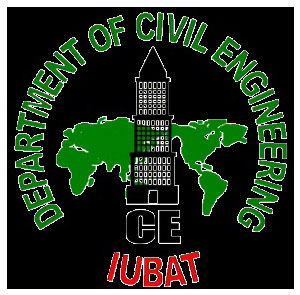
Dr. Md. Mahfuzur Rahman
Associate Professor & Coordinator
PhD in Hydrology (University of Chinese Academy of Sciences, China)
MSc in Hydrology (Hohai University, China)
BSc in Civil Engineering (IUBAT)
Room # 314 Ext # 306
E-mail: mfz.rahman@iubat.edu
Dr. Md. Mahfuzur Rahman is an Associate Professor and Coordinator in the Department of Civil Engineering, International University of Business Agriculture and Technology (IUBAT), Dhaka 1230, Bangladesh. He received his Bachelor of Science in Civil Engineering (3rd position) from IUBAT in 2014 and then started his academic career in his alma mater in the same year. Prior to joining IUBAT as a Lecturer in 2014, Mr. Rahman worked as a Research Assistant (RA) in the Civil Engineering Department at IUBAT. He obtained his Master of Science in Water Resources and Hydropower Engineering (Hydrology with 85% marks) from Hohai University in 2018 and a Ph.D. in Physical Geography (Hydrology with CGPA 4.00 out of 4.00 scale) from the University of Chinese Academy of Sciences (Ranked one globally based on the Nature Index) in 2021. During his Ph.D. tenure, Dr. Rahman was awarded the outstanding research student award in 2020 from his lab for outstanding publications in top-notch international journals.
Dr. Rahman has published over 40 peer-reviewed papers in prestigious international journals (SCI, EI, and Scopus) and conference proceedings (Scopus) with a cumulative impact factor of 117.275. The significance of his work is evident in his recent publications in three leading peer-reviewed international journals: Journal of Cleaner Production (Impact Factor: 11.072), Journal of Environmental Management (Impact Factor: 8.910), and Geoscience Frontiers (Impact Factor: 7.483). His work is highly recognized in the academic area. In addition, he acts as a reviewer for numerous international journals, i.e., Journal of Hydrology, CATENA, Journal of Environmental Management, Journal of Mountain Science, Stochastic Environmental Research and Risk Assessment, Natural Hazards, Geo-spatial Information Science, Scientific African, Acta Geodynamica et Geomaterialia, Water Resource Management, Sustainability (MDPI), Geoscience (MDPI), Petroleum Science and Technology, Geocarto International, etc. His research interests include advanced remote sensing techniques, hydraulic modeling, machine learning, and deep learning algorithms in natural hazards and statistical modeling. Dr. Rahman is an affiliated member of the American Society of Civil Engineers (ASCE) and the American Concrete Institute (ACI).
PhD in Hydrology (University of Chinese Academy of Sciences, China),
MSc in Hydrology (Hohai University, China),
BSc in Civil Engineering (IUBAT).
- ART 203 Career Planning and Development II
- CEN 231 Engineering Mechanics
- CEN 327 Engineering Hydrology
- CEN 401 Irrigation and Flood Control Engineering
List of Publications of Dr. Md. Mahfuzur Rahman
-- 2024--
- Md Mahfuzur Rahman. Optimizing health service location in a highly urbanized city: multi criteria -P-Median model for public hospitals in Jeddah city, KSA. Plos One. (SCI, Q2, IF: 3.7).
- Md Mahfuzur Rahman. Causal mechanisms and evolution processes of "block-burst" debris flow hazard chains in Mountainous Urban Areas: a case study of Meilong gully in Danba County, Sichuan Province. Frontiers in Earth Science. (SCI, Q1, IF: 2.9).
- Md Mahfuzur Rahman. Uncertainty Reduction of Flood Susceptibility Mapping using RF and XGBoost Algorithms in Two Tropical Desert City Shibam and Marib, Yemen. Remote sensing. (SCI, Q1, IF: 5.0).
- Raju, M. R., Rahman, M., Hasan, M. M., Sharmily, T., Hosen, M. S., Islam, M. M., & Hasan, N. M. S. (2023). A comparative study of machine learning methods for assessing the compressive strength of Pozzolanic concrete. IUBAT Review.
- Md Mahfuzur Rahman. Characteristics and causes of a catastrophic snow avalanche occurred on January 17, 2023 in Tibet. Landslides. (SCIE, Q1, IF: 4.45).
- Md Mahfuzur Rahman. Optimizing urban water sustainability: Integrating deep learning, genetic algorithm, and CMIP6 GCM for groundwater potential zone prediction within a social-ecological-technological framework. (SCI, Q2, IF: 2.6).
- Md Mahfuzur Rahman. Multi-hazard could exacerbate in coastal Bangladesh in the context of climate change. Journal of Cleaner Production. (SCI, Q1, IF: 11.1). Under Review.
- Md Mahfuzur Rahman. Uncovering the relationship between climate and LULC change for future increased landslide susceptibility in eastern Hindu Kush, Pakistan. (SCI, Q1, IF: 6.2). Under Review.
- Soil mass domination of low-frequency large-scale debris flow disasters in the limestone region of Qinghai-Tibetan Plateau. (SCI, Q1, IF: 6.2). Under Review.
- Md Mahfuzur Rahman. Utilizing machine learning to evaluate heavy metal pollution in the world's largest mangrove forest. Science of the Total Environment. (SCI, Q1, IF: 9.8). Under Review.
-- 2023 --
- Rahman, Mahfuzur, Md Sakib Hasan Tumon, Md Monirul Islam, Ningsheng Chen, Quoc Bao Pham, Kashif Ullah, Sumaiya Jarin Ahammed et al. "Could climate change exacerbate droughts in Bangladesh in the future?." Journal of Hydrology 625 (2023): 130096. (SCI, Q1, IF: 6.4).
- Hu, G., Huang, H., Tian, S., Rahman, M., Shen, H., & Yang, Z. (2023). Method on Early Identification of Low-Frequency Debris Flow Gullies along the Highways in the Chuanxi Plateau. Remote Sensing, 15(5), 1183. (SCI, Q1, IF: 5.0).
- Chen, N., Tian, S., Wang, F., Shi, P., Liu, L., Xiao, M., & Somos-Valenzuela, M. (2023). Multi-wing butterfly effects on catastrophic rockslides. Geoscience Frontiers, 14(6), 101627. (SCI, Q1, IF: 8.9).
- Tian, S., Hu, G., Chen, N., Rahman, M., Ni, H., & Somos-Valenzuela, M. (2023). Effects of tectonic setting and hydraulic properties on silent large-scale landslides: A case study of the Zhaobishan landslide, China. International Journal of Disaster Risk Science, 14(4), 600-617. (SCI, Q1, IF: 4.0).
- Rahman, Mahfuzur, Md Monirul Islam, Hyeong-Joo Kim, Shamsher Sadiq, Mehtab Alam, Taslima Siddiqua, Md Al Mamun et al. "Assessing the Influence of Land Cover and Climate Change Impacts on Runoff Patterns Using CA-ANN Model and CMIP6 Data." ISPRS International Journal of Geo-Information 12, no. 10 (2023): 401. (SCI, Q2, IF: 3.4).
- Md Mahfuzur Rahman. Unveiling the wrath of erosion: Assessing the impacts of soil erosion on the coastal region of Bangladesh. IUBAT Review.
- Li, Z., Wu, M., Chen, N., Hou, R., Tian, S., & Rahman, M. (2023). Risk Assessment and Analysis of Its Influencing Factors of Debris Flows in Typical Arid Mountain Environment: A Case Study of Central Tien Shan Mountains, China. Remote Sensing, 15(24), 5681. (SCI, Q1, IF: 5.0).
- Islam, M. M., Rahman, M., Nargis, S., Ahamed, M. R., Mollik, R. S., Boby, N. J. K., & Aziz, M. A. (2023). Elevating Health of the Turag River: A Synergistic Water Quality Assessment Approach. Earth Systems and Environment, 1-20. (SCI, Q1, IF: 7.2).
- Raju, M. R., Rahman, M., Hasan, M. M., Islam, M. M., & Alam, M. S. (2023). Estimation of concrete materials uniaxial compressive strength using soft computing techniques. Heliyon, 9(11), e22502. (SCIE, Q1, IF: 4.45).
-- 2022 --
- Md Mahfuzur Rahman. Optimizing urban water sustainability: integrating deep learning, genetic algorithm, and CMIP6 GCM for groundwater potential zone prediction within a social-ecological-technological framework. Journal of the Geological Society of India. (SCI, Q1, IF: 1.459)
- Md Mahfuzur Rahman. A state-of-the-art review on the advancement of sustainable vegetation concrete in slope stability. Construction and Building Materials. (SCI, Q1, IF: 6.141).
- Md Mahfuzur Rahman. Landslide Susceptibility Mapping with Deep Learning Algorithms. Sustainability. (SCI, Q1, IF: 3.251).
- Md Mahfuzur Rahman. Extreme climate and tectonic controls on the generation of a large-scale, low-frequency debris flow. Catena. (SCI, Q1, IF: 5.198).
- Md Mahfuzur Rahman. New insights into the occurrence of the catastrophic Zhaiban slope debris flow that occurred in a dry valley in the Hengduan Mountains in southwest China. Landslides. (SCI, Q2, IF: 6.578).
- Md Mahfuzur Rahman. How do multiple kernel functions in machine learning algorithms improve precision in flood probability mapping? Natural Hazards. (SCI, Q1, IF: 3.7).
- Md Mahfuzur Rahman. Determining trigger factors of soil mass failure in a hollow: A study based in the Sichuan Province, China. Catena. (SCI, Q1, IF: 5.198).
- Md Mahfuzur Rahman. Multi-hazard susceptibility mapping based on Convolutional Neural Networks. Geoscience Frontiers. (SCI, Q1, IF: 6.853).
- Md Mahfuzur Rahman. Sustainable flood risk assessment using deep learning-based algorithms with a blockchain technology. Geocarto International. (SCI, Q2, IF: 3.8).
- Md Mahfuzur Rahman. Small outbursts into big disasters: Earthquakes exacerbate climate-driven cascade processes of the glacial lakes failure in the Himalayas. Geomorphology. (SCI, Q1, IF: 3.9).
- Md Mahfuzur Rahman. Preliminary analysis on the formation mechanism of the unexpected catastrophic Qijiaba landslide in a tectonically non-active hilly area of China. Landslides. (SCI, Q2, IF: 6.578).
- Md Mahfuzur Rahman. Estimate earth fissure hazard based on machine learning in the Qa’ Jahran Basin, Yemen. Scientific Reports. (SCI, Q1, IF: 4.6).
-- 2021 --
- Development of flood hazard map and emergency relief operation system using hydrodynamic modeling and machine learning algorithm. Journal of Cleaner Production. (SCI, Q1, IF: 9.297).
https://www.sciencedirect.com/science/article/abs/pii/S0959652621018126 - Flooding and its relationship with land cover change, population growth, and road density. Geoscience Frontiers. (SCI, Q1, IF: 6.853).
https://www.sciencedirect.com/science/article/pii/S1674987121000888 - Application of stacking hybrid machine learning algorithms in delineating multi-type flooding in Bangladesh. Journal of Environmental Management.(SCI, Q1, IF: 6.789).
https://www.sciencedirect.com/science/article/pii/S0301479721011488 - Geohazards susceptibility assessment along the Upper Indus Basin using four machine learning and statistical models. ISPRS Journal of Geo-information. (SCI, Q3, IF: 2.899).
https://www.mdpi.com/2220-9964/10/5/315 - Failure mechanism of the Yaoba loess landslide on March 5, 2020, the early-spring dry spell in Southwest China. Landslides. (SCI, Q2, IF: 6.578).
https://link.springer.com/article/10.1007/s10346-021-01703-8 - Influence of drainage and root biomass on soil mechanical behavior in triaxial tests. Acta Geotechnica. (SCI, Q1, IF: 5.856).
https://link.springer.com/article/10.1007/s11440-021-01380-w - Effect of root orientation on the strength characteristics of loess in drained and undrained triaxial tests. Engineering Geology. (SCI, Q1, IF: 6.755).
https://www.sciencedirect.com/science/article/pii/S0013795221004701 - New insights into the occurrence of a catastrophic slope debris flow in the dry valley of Hengduan Mountains, Southwest China. Landslides (2021): XXX. (SCI, Q2, IF: 6.578).
https://link.springer.com/article/10.1007/s10346-021-01824-0 - Determination of Pollutant of River Turag Coming from Surrounding Industries. IUBAT Review 4 (1): 1-9.
- Flood assessment and early warning of the reoccurrence of river blockage at the Baige landslide. Journal of Geographical Sciences. (SCI, Q1, IF: 3.543).
https://link.springer.com/article/10.1007/s11442-021-1918-9
-- 2020 --
- Location-allocation modeling for emergency evacuation planning with GIS and remote sensing: a case study of northeast Bangladesh. Geoscience Frontiers (2021). (SCI, Q1, IF: 6.853).
https://www.sciencedirect.com/science/article/pii/S1674987120302279 - New insights into the occurrence of the Baige landslide along the Jinsha River in Tibet. Landslides (2020): 1-10. (SCI, Q2, IF: 6.578).
https://link.springer.com/article/10.1007/s10346-020-01351-4 - Effects of loose deposits on debris flow processes in the Aizi Valley, southwest China. Journal of Mountain Science 17(1) (2020): 156-172. (SCI, Q3, IF: 2.071).
https://link.springer.com/article/10.1007%2Fs11629-019-5388-9 - Scaling the Roots Mechanical Reinforcement in Plantation of Cunninghamia R. Br in Southwest China. Forests 2021(12): 33. (SCI, Q3, IF: 2.633).
https://www.mdpi.com/1999-4907/12/1/33 - Evaluation of Residential Water Conservation Practice of Dhaka Bangladesh. IUBAT Review.
-- 2019 --
- Flood susceptibility assessment in Bangladesh using machine learning and multi-criteria decision analysis. Earth Systems and Environment 3(3) (2019): 585-601. (EI and ESCI).
https://link.springer.com/article/10.1007/s41748-019-00123-y - GLOF Risk Assessment Model in the Himalayas: A Case Study of a Hydropower Project in the Upper Arun River. Water 11(9) (2019): 1839. (SCI, Q3, IF: 3.103).
https://www.mdpi.com/2073-4441/11/9/1839/htm - Development of multi-hazards map for Bangladesh using GIS technique. IUBAT Review.
- Vulnerability Analysis for Sustainable Development against Flood Hazard and Relief Distribution: A Case Study of 2017 Flood of Bangladesh. IUBAT Review.
Conferences:
- Flood hazard assessment of Bangladesh: A Case Study of 2017 Flood. The Second International Symposium on Hydraulic Modeling and Measuring Technology 2018, Nanjing, China.
- Development of multi-hazard vulnerability map of Bangladesh using geographic information system. The Second International Symposium on Hydraulic Modeling and Measuring Technology 2018, Nanjing, China.
- Vulnerability Analysis for Sustainable Development against Flood Hazard and Relief Distribution: A Case Study of 2017 Flood of Bangladesh. 13thInternational Knowledge Globalization Conference 2018, Dhaka, Bangladesh.
- Scopes and Challenges of Hydro-Climatic Condition in Bangladesh: A Review Considering Natural Variability and Future Changes.13thInternational Knowledge Globalization Conference 2018, Dhaka, Bangladesh.
Professional Training:
1. International Training Course on Silk Road Disaster Reduction (2019), Organized by IMHE, CAS.
2. Training on Teaching-Learning, Curriculum and Quality Assurance, Bangladesh (2016), organized by Graduate Training Institute (GTI), Bangladesh Agricultural University (BAU).
Honors/Awards:
- IMHE PhD Fellowship, 2018
- Hohai Masters Fellowship, 2016
- IUBAT Undergrad Merit Scholarship, 2011

